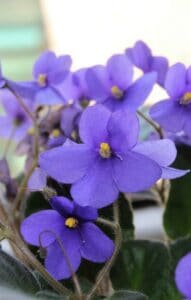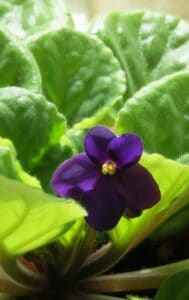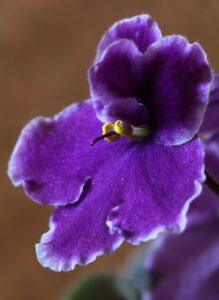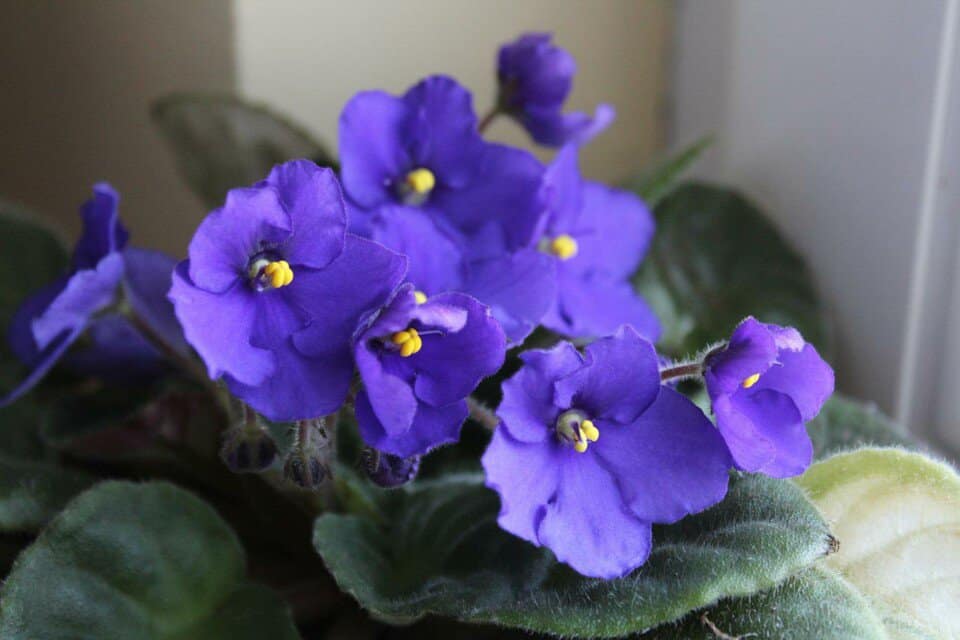Some links in the post are affiliate links and I get a commission from purchases made through some links found in the post.
An African violet is just a type of violet, right? I thought so, too, for a long time. In fact, when I bought my African violet, I remember interchanging its name with the violet.
I would tell people that I had a violet in my home. Little did I know that there were two distinct violet categories – the true violets and the African violets. I break down what makes them different and similar in this short guide.
Are Violets and African Violets the Same?
 Not at all. You’d be forgiven for thinking that these two are violets and might even describe them using the same word as I did. But that would not be right.
Not at all. You’d be forgiven for thinking that these two are violets and might even describe them using the same word as I did. But that would not be right.
Violets, also known as viola (in Latin), belong to the family Violaceae. Their genus, known as Viola, comprises hundreds of violet species native to the northern hemisphere.
You can also find them in the Andes in South America. They generally do well in temperate conditions and love being kept in humid spaces.
Even so, they enjoy a bit of shade and will not do very well in the full sun. Interestingly, these plants can be perennial or annual.
They take on small shapes, with some exhibiting as shrubs. Violets from the genus Viola are known as true violets.
How about the African violets? These belong to the Streptocarpus genus. They were first available as the S. Ionantha, but more species have since become available.
They are as varied as the true violets, with species producing single and double flowers in many colors.
The differences between the the African Violet and the Violet mainly lies in their genus, root systems, light preferences, and blooming, as I will detail below.
Please note that any mention of violets henceforth will refer to true violets, while African violets will be termed as such. Let’s get started:
African Violet Vs Violet – What Are the Similarities?
Do these plants share any common ground? Of course, they do! Their similarities include:
Their Love for Heat and Humidity
True violets do well in temperature ranges between 40- and 70-degrees Fahrenheit. Since they grow outdoors, they can keep up with colder ranges but will not survive below 20 degrees.
At this point, the flowers get destroyed, and the plant suffers distress. African violets also prefer warmer climates and do best at 70 degrees.
You can lower the temperatures as needed. But once you hit the 60-degree-mark, the temperatures become less than ideal, and the plant can stop flowering.
Additionally, both plants are humidity-loving and do well in moderate to high humidity. If you want them to grow healthier, consider misting them or growing them among other plants.
They Are Flowering Plants
Whether you go for the true violet or the African violet, you can always expect a bloom each year. Of course, the African violet flowers for longer – but they all have beautiful blooms.
You can encourage them to bloom by keeping the soil moist, feeding the plants regularly, and ensuring they get access to enough light to trigger bud production.
They Are Regular Feeders
For these violets to produce healthy blooms, you must feed them during the growing season. For the true violet, this would be in the spring and summer.
You should use a slow-release fertilizer to ensure the plant does not get too much of any nutrient that can trigger leggy growth.
As for the African violet, the growing season is all year. As such, you should use the specific African violet fertilizer in its potting soil twice a month.
You may also like: Can African violets grow outside
African Violet Vs Violet – What Are the Differences?
Potato, potato is not quite the case. It turns out that while these plants may share a term in their names, they do have some distinct differences that affect how and where you can grow them. What are they?
Their Root Systems
 True violets feature a deep-root system. They are best grown outdoors, where their roots can establish in the ground, enabling them to reach the water tables beneath the ground.
True violets feature a deep-root system. They are best grown outdoors, where their roots can establish in the ground, enabling them to reach the water tables beneath the ground.
These plants do best when in well-draining and rich soil. You can achieve this balance with a peat-based soil mix. If the soil drains too much water, you can amend it with compost to increase its water retention rate.
And if it does not drain enough water, you should add coarse materials like sand to get things going. Because of their deep root systems, you should avoid overwatering the plants.
They enjoy regular soaking, but when the roots have too much access to water, they drown and die. Luckily, the plants can survive prolonged periods of neglect by relying on their roots to reach more water in the lower tables.
However, they stop producing blooms when they go without water for too long.
Can you plant the true violet indoors? These plants are pretty hardy and can survive the outdoors quite well. It’s advisable to sow them directly into the soil and allow them to establish in the ground.
Their deep root systems would have difficulty spreading in pots, and you would need to repot often. Besides, some have trailing habits and would not do quite well in limited space.
The African violet is best grown indoors and is the more common houseplant of the two. It features a shallow root system which allows it to grow well in pots.
The plant enjoys being slightly rootbound, and you can thus allow it to take up most of the space in the pot for a while before moving it to another pot.
However, you should repot the plant if it shows yellowing, falling leaves, protruding roots, or water welling up on the surface.
What kind of soil does the African violet need? This plant is not unlike the true violet in this case – it does well in well-draining soil.
Its shallow roots do not take too well to being in water for prolonged periods. Thus, it can die due to root rot resulting from overwatering.
The best approach is to keep the soil slightly moist to allow leaf and flower production throughout the year.
And because its leaves are sensitive to water damage, you should not water the plant from its tip but rather from its base or below the pot.
Their Flowering
Most people who grow the African violet, including me, do so because this plant can flower throughout the year. That’s right!
If the plant has access to adequate light, water, and nutrients, it keeps flowering throughout the seasons and can even produce flowers in the colder months.
But the true violet does not boast this tendency. Instead, most of its species start flowering from spring to summer, and the flowers are no more by fall.
Thus, anyone who wants to enjoy a fresh bouquet every season can lean on the African violet.
Their Light Preferences
Let’s start with the true violet. This plant is native to temperate regions and thus does well in the full sun – this is bright and direct light for at least 6 hours a day.
You can place it in the direct sun, and it would still survive. But is this its ideal light exposure?
Not quite. If you want your true violet to grow well, you should locate it in a spot with partial sun exposure – this is bright and indirect light for at least 4 hours a day.
And this should be to the east of the garden, which receives morning sun rather than the west with harsh afternoon rays.
What happens when the true violet has too much sun exposure? Not only can this burn its leaves, but this also affects its ability to flower.
Flower drop also happens faster due to the stress on the plant. Please note that this occurs in the higher USDA zones.
Can the African violet grow in the full sun? Not at all. The African violet prefers bright and indirect light and would not grow well in the full sun.
Thus, they are best kept indoors where you can position them near east or west-facing windows.
You can also grow them using artificial lights to protect them from direct sunlight further. Interestingly, most African violets are frost-tolerant but will not keep up with direct sunlight.
Their Appearance
 True violets come in many forms, depending on their species. Their flowers, which come out in small sizes, generally grow on a single stalk and feature five petals.
True violets come in many forms, depending on their species. Their flowers, which come out in small sizes, generally grow on a single stalk and feature five petals.
You can tell the species of a particular violet by observing the end of its petal, which features a spur. Moreover, the colors of the flowers vary per species.
In some cases, the flowers are blue. And in others, the flowers come in yellow, white, cream, or a combination of blue and yellow.
Like the true violets, African violets also produce flowers that feature five petals. However, their flowers feature an eye on each bloom which is not a characteristic of true violets.
Additionally, these plants have fleshy leaves and are known to flower throughout the year.
In the right conditions, the African violet can bloom continuously for five decades, more so in the summer. And if kept indoors, the flowering can occur even during the colder months.
Final Thoughts
Did you know that true violets offer more than aesthetic value? These flowers have long been consumed as salads or even medicines.
However, you should be careful when ingesting the flowers or their derivatives, as too much of anything can be toxic. It’s always best to go with the recommended dosage and save some flowers for the bouquet.
Happy Gardening!


